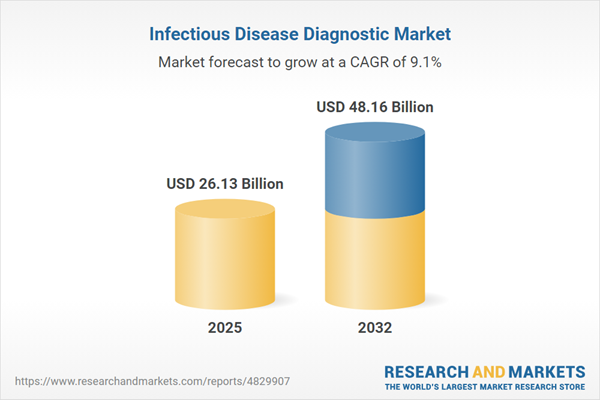Speak directly to the analyst to clarify any post sales queries you may have.
The infectious disease diagnostic market is transforming rapidly, shaped by accelerating digital advancements and ongoing innovation that require proactive strategies from senior healthcare executives facing dynamic global challenges and opportunities.
Market Snapshot: Infectious Disease Diagnostic Market Size, Growth, and Momentum
In 2024, the infectious disease diagnostic market reached USD 24.07 billion, with projections showing growth to USD 26.13 billion in 2025 and an expansion to USD 48.16 billion by 2032. This robust trajectory is driven by a strong compound annual growth rate of 9.05%. Key drivers include technological innovation in molecular diagnostics, immunoassay advances, and next-generation sequencing. Digital tools, automated processes, and integrated laboratory systems are enabling greater operational efficiency across diagnostics workflows. Evolving global regulations influence market approaches, as organizations adapt strategies to address changes in healthcare requirements and emerging infection threats across multiple regions.
Scope & Segmentation of the Infectious Disease Diagnostic Market
Understanding market segmentation enables leaders to direct resources efficiently and target the highest-growth areas. The main segmentation areas include:
- Product Categories: Encompass instruments, diagnostic kits, reagents, and software platforms, supporting versatile implementation across laboratory and point-of-care environments.
- Instrument Types: Cover immunoassay analyzers, microarrays, mass spectrometers, and PCR systems, which contribute to tailored detection and adaptability for diverse infection types.
- Reagent & Kit Types: Span antigen detection kits, ELISA tests, and PCR reagents, supporting rapid and specific identification at multiple points of care.
- Sample Types: Include blood, stool, nasal, rectal, throat swabs, and urine, allowing broad diagnostic reach and compatibility with various clinical protocols.
- Testing Modalities: Feature centralized laboratory and decentralized point-of-care testing, meeting the demands of both large-scale operations and site-specific diagnostic needs.
- Pathogen Profiles: Address bacterial, viral, fungal, and parasitic targets, supporting robust public health responses.
- Disease Classifications: Cover endemic illnesses and new infectious risks, ensuring complete coverage of potential threats.
- End Users: Represent hospitals, clinics, academic centers, diagnostic laboratories, and research organizations, working together to maintain quality standards across different healthcare systems.
- Geographic Regions: Span the Americas, Europe, Middle East & Africa, and Asia-Pacific, each presenting unique opportunities influenced by local regulations and healthcare priorities. Key markets—such as the U.S., Germany, China, India, UAE, Canada, and Brazil—reflect evolving regulatory and competitive landscapes.
- Key Companies: Include Bio-Rad Laboratories, Abbott Laboratories, Roche, Agilent Technologies, Danaher, Siemens Healthineers, and Thermo Fisher Scientific, setting standards in technology and service scope.
Key Takeaways for Senior Decision-Makers
- Digital adoption and next-generation sequencing are accelerating laboratory integration, enabling more responsive decision-making and enhanced clinical data exchange.
- Collaboration across public and private sectors supports innovation, providing scalable diagnostic access in both established and growing healthcare environments.
- Multi-platform diagnostic solutions enable smooth transitions between centralized laboratories and decentralized settings, maintaining operational agility during organizational enhancements or market changes.
- AI and telemedicine integration broadens accessible diagnostic coverage, streamlining response capabilities in settings with variable healthcare needs.
- Compliance with local regulations and alignment with healthcare protocols drive operational performance in different regions.
- Continuous supply chain improvements and stringent regulatory adherence are essential for ensuring steady availability of critical diagnostic products amid changing global events.
Tariff Impact: Navigating Regulatory and Supply Chain Shifts in 2025
With anticipated U.S. tariff adjustments on the horizon in 2025, diagnostic providers are strengthening their supply chain strategies. Efforts include the expansion of regional manufacturing hubs, tighter inventory controls, and diversification of supplier partnerships. These measures aim to build resilience, support regulatory compliance, and maintain seamless operations as the market adapts to new trade policies.
Methodology & Data Sources
This report’s insights derive from direct interviews with laboratory executives, continual review of peer-reviewed academic research, and detailed analysis of industry and regulatory documents. The multi-source approach ensures dependable, strategic intelligence for stakeholders in the B2B healthcare sector.
Why This Report Matters for B2B Decision-Makers
- Delivers actionable market intelligence, supporting stronger regulatory preparedness, technology integration, and informed decisions around business expansion.
- Clarifies core segments to optimize resource allocation and identify markets and applications primed for sustainable growth.
- Guides leaders through compliance, supply chain management, and operational tailoring according to local market dynamics and evolving clinical needs.
Conclusion
This report equips senior executives with comprehensive, segmented insights to strengthen resilience, adapt to regulatory changes, and steer informed organizational growth in the dynamic infectious disease diagnostic field.
Additional Product Information:
- Purchase of this report includes 1 year online access with quarterly updates.
- This report can be updated on request. Please contact our Customer Experience team using the Ask a Question widget on our website.
Table of Contents
3. Executive Summary
4. Market Overview
7. Cumulative Impact of Artificial Intelligence 2025
Companies Mentioned
The companies profiled in this Infectious Disease Diagnostic market report include:- Bio-Rad Laboratories, Inc.
- F. Hoffmann-La Roche Ltd.
- Abbott Laboratories
- Adaptive Biotechnologies Corporation
- Agilent Technologies, Inc.
- Becton, Dickinson and Company
- Bio-Techne Corporation
- bioMérieux SA
- Boston Scientific Corporation
- Bruker Corporation
- Cardinal Health Inc.
- Cook Medical Incorporated
- Danaher Corporation
- GE HealthCare Technologies Inc.
- Grifols, S.A.
- Hologic Inc.
- Illumina, Inc.
- Johnson & Johnson Services Inc.
- Konica Minolta, Inc.
- Koninklijke Philips N.V.
- MedMira Inc.
- Medtronic PLC
- Merck KGaA
- Olympus Corporation
- Perkin Elmer, Inc.
- Pfizer Inc.
- Qiagen N.V.
- Quest Diagnostics Incorporated
- Siemens Healthineers AG
- Sysmex Corporation
- Thermo Fisher Scientific, Inc.
- Trivitron Healthcare
Table Information
| Report Attribute | Details |
|---|---|
| No. of Pages | 187 |
| Published | November 2025 |
| Forecast Period | 2025 - 2032 |
| Estimated Market Value ( USD | $ 26.13 Billion |
| Forecasted Market Value ( USD | $ 48.16 Billion |
| Compound Annual Growth Rate | 9.0% |
| Regions Covered | Global |
| No. of Companies Mentioned | 33 |









